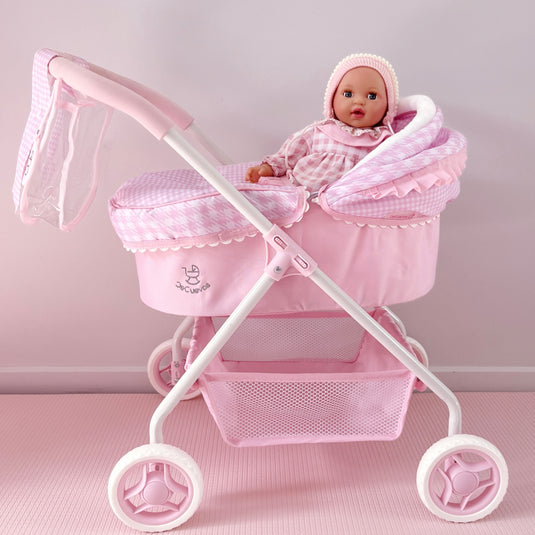Get This Report about Dolls And Accessories
Get This Report about Dolls And Accessories
Blog Article
The Main Principles Of Dolls And Accessories
Table of ContentsThe Best Guide To Dolls And AccessoriesThe Facts About Dolls And Accessories RevealedGet This Report about Dolls And AccessoriesDolls And Accessories - TruthsThe Only Guide to Dolls And AccessoriesNot known Facts About Dolls And AccessoriesDolls And Accessories Fundamentals Explained
When dolls are consisted of in team play, youngsters exercise waiting, sharing, and listening to others' concepts. Whether they're claiming to be a parent, sibling, or friend, children learn how connections workhow to support others, address arguments, and look after another person. These very early role-play experiences end up being the groundwork for healthy relationships and connections later in life.Duplicating reassuring routines with a doll (feeding, shaking, placing to bed) can help youngsters really feel calm and protected. These calming routines show them how to self-regulate. Caring for a doll can make a kid feel capable and positive - european dolls. It provides them a feeling of responsibility and control in a globe that frequently really feels unpredictable.
Dolls And Accessories Can Be Fun For Anyone
When kids see dolls that show their race, heritage, and culture, it reinforces a positive sense of identification. Dolls additionally introduce children to cultures outside their very own, developing considerate curiosity and empathy for others.
As Dr. Karyn Purvis, a leader in youngster development and trauma-informed treatment, when claimed: This powerful quote highlights just how play isn't simply funit's exactly how children find out finest. The brain wires itself via repeating. When a kid is involved, happy, and emotionally linked to an activitylike doll playthe mind reinforces those links quicker and more meaningfully.
Getting The Dolls And Accessories To Work

Kids need empathy, compassion, and creativity tooand doll play supplies that. Dolls are typically a kid's first "buddy," assisting them practice relationships, develop interaction abilities, and feel comforted.
5 Simple Techniques For Dolls And Accessories
With play. With satisfaction. Via dolls that matter. Many thanks for joining us on this trip. Samantha Ong Samantha Ong is the owner of Joeydolls, a Canadian-based plaything brand on an objective to commemorate Oriental societies via cheerful, comprehensive play. Influenced by her very own experiences maturing without social depiction, Samantha creates dolls that aid youngsters feel honored of who they are while sparking curiosity and compassion in others.
Playing with dolls encourages youngsters to speak even more concerning others' thoughts and emotions, a study has actually discovered. The research suggests that playing fictional games with dolls could assist kids develop social abilities, theory of mind and empathy. The neuroscientist that led the work stated that the educational worth of having fun with Lego and building playthings was extensively accepted, however the benefits of playing with dolls occasionally appeared to have actually been overlooked."When children produce fictional worlds and function have fun with dolls, they connect initially aloud and then internalise the message regarding others' ideas, feelings and feelings," stated Dr Sarah Gerson, a neuroscientist at Cardiff College and the lead author.
Dolls And Accessories for Dummies
They were also more probable to address the dolls in the 2nd person, speaking with them straight, whereas the characters on the computer system display they tended to describe in the 3rd individual. No difference was observed between young boys and women."Interior state language can indicate that a kid is thinking of other individuals's thoughts and emotions while having fun with dolls," stated Gerson.
And that they see language use hereof is great verification of the theory."Mardell added that the findings should relate to any type of type of role-play plaything, as opposed to being certain to Barbies. "I would certainly take a broader view of what a doll is," he stated." [It might be] any kind of things that the youngster can spend a sense of various other into a packed animal, a stove glove that chats to them, or perhaps an imaginary close friend."Children usually start to show indicators of interior state language around the age of 4.
Getting The Dolls And Accessories To Work
"It becomes important for making and maintaining relationships, and how they find out from their instructors, and moms and dads."The study likewise located that the children had actually increased brain activity in the posterior superior temporal sulcus (pSTS) area when they talked as though their dolls had ideas and sensations. The pSTS area is believed to be included in the growth of social and psychological handling abilities.
Youth is not a static life phase; undoubtedly, the definition, meaning and understanding of childhood years are all based on adjustment. By the nineteenth century among one of the most profound modifications was the importance put on allowing youngsters to experience "the carefree happiness" of childhood years through playtime tasks. Play was now considered to be a critical part of a great childhood years.
In order to completely recognize the significance of play, one must also understand the significance of the doll. Dolls are much more than playthings made to entertain young girls. During the 19th century appropriate play tasks were picked to advertise intellectual, physical or psychological development. Dolls were specifically popular due to the fact that they were believed to promote and nurture feminine qualities such as generosity, caring and empathy.
Unknown Facts About Dolls And Accessories

It is only via historical investigations that scientists can wish to uncover and document the full variety of playtime experiences. Chronicling these experiences, and particularly the role of dolls, is essential for offering a more total photo of youth during the 19th century. Alarcn, Sara E - doll clothes., "Child's Play: The Function of Dolls in 19th Century Childhood" (2007 )
Report this page